
Pond/Lake Stocking
We offer Rainbow, Brook, Brown Trout, Hybrid Blue Gill, Yellow Perch, Largemouth Bass, Smallmouth Bass and Fathead Minnows, Crappie, Walleye, Bluegill & Channel Catfish - Please call for availability and prices.Stocking Prices
2025 Stocking PricesSpecies Information
Rainbow Trout Brook Trout Brown Trout Walleye Bluegill Yellow PerchRainbow Trout (Oncorhynchus mykiss)
Identifying characteristics: (Non-Native Fish) Rainbow trout are generally blue-green or olive green with heavy black spotting over the length of the body. The tail fin is squarish and slightly forked. Adult fish have a broad pink or reddish stripe along the lateral line, from gills to the tail, which is most pronounced in breeding males. Although not native to Michigan, rainbow trout have become one of the state's favorite sport fish. From the inland lakes and streams to the Great Lakes, rainbows provide countless hours of angling enjoyment to all manner of fishermen. Adult rainbow trout reach an average of 10-13 inches and weigh between 1 and 5 lbs, although some may reach upwards of 20 inches in length. They prefer cool, clear rivers, streams, and lakes, though some will leave their freshwater homes and follow a river out to the sea. These migratory adults, called steelheads because they acquire more silvery markings, will spend several years in the ocean, but must return to the stream of their birth to spawn. Rainbow trout generally spawn in early to late spring when water temperatures reach at least 42° to 44° F. Spawning sites are usually a bed of fine gravel. A female trout clears a redd (or spawning bed) in the gravel by turning on her side and beating her tail up and down. Female rainbow trout usually produce 2000 to 3000 eggs per kilogram of weight. During spawning, the eggs fall into spaces between the gravel, and immediately the female begins digging at the upstream edge of the nest, covering the eggs with the displaced gravel. The eggs usually hatch in about four to seven weeks. In approximately two weeks, the yolk sac is completely consumed and fry commence feeding mainly on zooplankton. Rainbow trout are predators with a varied diet and will eat nearly anything they can capture. Rainbow trout routinely feed on larval, pupal and adult forms of aquatic insects (typically caddisflies, stoneflies, mayflies and aquatic diptera). Like any trout, stream rainbows can be caught with a various baits and lures including worms, crickets, grasshoppers, wet and dry flies, spoons, and spinners.Brook Trout (Salvelinus Fontinalis)
Identifying characteristics: (Native Fish) Brook trout have a long, streamlined body with a large mouth that extends past the eye. Color variations include olive, blue-gray, or black above with a silvery white belly and wormlike markings (vermiculations) along the back. They have red spots sometimes surrounded by bluish halos on their sides. The lower fins have a white front edge with black and the remainder being reddish orange. The tail fin is square or rarely slightly forked. During breeding time in the fall male brook trout can become very bright orange-red along the sides. The brook trout is native to Michigan’s waters and is the state fish of Michigan. They can be found throughout most of the state in many creeks, streams, rivers, lakes, and in the Great Lakes. Brook trout require cool, clear, spring-fed streams and pools. They can be found under cover of rocks, logs, and undercut banks and have been described as stationary. Larger brook trout often inhabit deep pools moving to shallow water only to feed. They prefer temperatures from 57-60° F.Brown Trout (Salmo Trutta)
Identifying characteristics: (Non-Native Fish) Two dorsal fins including one adipose fin, broad square tongue with 11-12 large teeth, light pectoral fins, squire tail, 9-10 rays in the anal fin. Brown trout is something of a misnomer for many Great Lakes members of this species, since lake-run browns are predominately silver in color. In addition, the body spots, so characteristic of their stream-dwelling cousins, are often obscured in lake-dwellers. Brown trout are close relative of the Atlantic salmon, and also were brought to North American waters as exotics. These natives of Europe and western Asia were introduced into New York and Michigan waters in 1883. Brown trout have thrived in their new home, and have become firmly established in all of our upper Great Lakes waters. Lake dwelling brown trout are a wary lot. They hide in shallow water weed beds and rocky, boulder-strewn areas, and prefer a water temperature of 65-75° F. Since brown trout spawn in tributary streams in September and October, they begin to take up residence near stream outlets in spring and early summer. After ascending a particular stream, brown trout spawners choose shallow, gravelly or rocky areas. The female creates a shallow depression (redd) in the gravel, in which the spawning fish deposit the eggs and sperm. When the process is completed, the female covers the redd with gravel. The average lake run adult weighs 8 pounds, although individuals can grow to be much larger. Young browns are preyed upon by larger fish and by predatory birds such as mergansers. The diet of adult brown trout includes insects and their larvae, crustaceans, mollusks, amphibians, small rodents and other fish. They enjoy a rather long life-span, it appears, since researchers have observed them at up to 13 years of age.Walleye (Sander Vitreus)
Identifying characteristics: (Native Fish) Two dorsal fins separated into a spiny and a soft-rayed portion, cloudy eye, white tips on anal and lower caudal fins, canine teeth. Walleye are the largest member of the perch family. They lack the distinctive vertical bar makings of the yellow perch and have fan-like canine teeth. These battling fish are exciting to catch, delicious to eat and because they feed actively all winter, they provide a fine year-round sport fishery. In spring and fall walleyes congregate in shallow bay waters of the great Lakes, where they seek out rocky areas and submerged bars. During the bright part of the day they retreat in schools to the shade of deep waters or submerged objects. In the summer, walleyes range into cooler, deeper waters. They prefer a water temperature of 55-68° F and are seldom found in waters deeper than 50 feet. Walleyes are greedy predators. They eat small bass, trout, pike, perch and sunfishes. Prime feeding times are early morning and evening. Although in turbid waters walleyes are active throughout the day. Walleyes often associate with yellow perch, smallmouth bass, northern pike and muskellunge. In April and May, walleyes spawn over rock shoals. Males mature at age two to four years, females at three to six years. The average walleye caught by anglers is three years old and weighs from one to three pounds. Northern pike and muskellunge prey heavily on walleyes, while yellow perch, smallmouth bass and lake whitefish compete with walleyes for food. A close relative and look-alike of the walleye, the sauger shares habitat and, to some extent food sources with walleyes. Sauger are more adaptable to turbid water than walleyes are. Like walleyes, they are sight feeders which shy away from intense light, so they are most active at dawn, dusk and on cloudy days. Immature augers feed on plankton and aquatic insects, while adults prey on small fish, insects, crayfish and leeches.Bluegill (Lepomis Macrochirus)
Identifying characteristics: (Native Fish) Two dorsal fins with spinous and soft-rayed portions united, small mouth, long pointed pectoral fins, faint black spot on soft-rayed part of dorsal fin separates the bluegill from other sunfish, which lack this dorsal coloration. The sunfish family, or Centrarchidae, includes such popular panfish as bluegills, rock bass and large and smallmouth bass. The members of this family resemble the perch and sea bass families, but they differ in that the sinous and soft portions of the dorsal fin are united and confluent. The large mouth bass is an exception, with a deep notch between the front and rear parts of the dorsal fin. The Centrarchidae generally prefer warm water, and are nesting fishes. That is, the males scoop out a depression where one or more females deposit eggs. The males then fertilize and guard the eggs and the newly hatched young. The bluegill is a native to eastern and central North America, including the lower Great Lakes. This fish enjoys a well-deserved popularity with anglers. Many a young angler boasts the delicious bluegill as a first catch, while seasoned anglers using light tackle find it a valiant fighter. Bluegills favor warm waters (64-70° F) with plenty of cover such as weed beds, submerged logs, or drop-offs. They usually stay in relatively shallow water, but as temperatures rise in the summer, large bluegills will head for deeper water. This fish also provides good winter sport since it remains active all winter long. The bluegill spawns in the shallows in the late spring or early summer when the water temperature reaches 65° F. Males build nesting colonies in gravel, sand or mud and will guard the eggs and newly hatched fry until they reach the swimming stage. The young fry eat algae and zooplankton. As they grow larger, bluegills add small fish, aquatic insects and plant matter to their diet. The bluegill feeds off the surface of the water the midwaters and the bottom, where it can be a serious competitor with other bottom feeding fish. The average adult bluegill is 6 to 8 inches long, although some reach 10 inches. Sexual maturity occurs at 2 to 3 years for males and 3 to 4 years for females. Average life-span of these fish is 5 to 6 years.Yellow Perch (Perca Flavescens)
Identifying characteristics: (Native Fish) Two dorsal fins separated into a spiny and soft-rayed portion, yellow sides, seven blackish bars on the sides, no canine teeth. The yellow perch and walleye, members of the Percidae or perch family, are characterized by a dorsal fin, which is completely divided into a spiny and a separate soft-rayed portion. Both are important game fish in the Great Lakes area. Yellow perch have the distinction of being the most frequently caught game fish in Michigan. In addition their reputation as a tasty treat makes them a doubly valuable Great Lakes product. The gregarious perch travel in schools, generally preferring relatively shallow waters near shore. They are rarely taken from waters more than 30 feet deep, although in spring and fall they inhabit shallower areas than they do in the heat of the summer, they tend to travel shoreward each morning and evening to feed, while during the spring and fall they appear to feed throughout the day. At night they appear to rest on the bottom and refrain from feeding. Unlike many Great Lakes fish species, perch remain active all winter long under the ice in both shallow and deeper water, hence they provide the ice fisherman with much sport and many a meal. When given the choice, perch prefer a water temperature of 66-70° F and some suggest they follow the 68° F water temperature levels in their seasonal movements. They inhabit all the Great Lakes, with greatest Michigan concentrations in Lake Erie, Lake St. Clair, Saginaw Bay, the eastern end of the U.P. and southern Michigan. Adult perch dine primarily on immature insects, larger invertebrates, (crayfish, etc.) and the eggs and young of other fish, which they take both from open water and from the bottom. In turn, bass, walleye, and northern pike all prey on perch. Perch average adult length is 4-10 inches, with a weight of 4-10 ounces, although adult size is quite variable. Perch are prolific breeders, but growth and ultimate size depend on population density and habitat productivity. Crowding results in stunted offspring that may never exceed a length of six inches; thus, a controlled harvest program can benefit both the angler and the fish themselves. Male perch reach sexual maturity at about three years of age, females at four. Perch spawn in the spring, laying eggs in gelatinous strings over dense vegetation, roots, and fallen trees in the shallows. These spawning grounds provide some of the best perch fishing available. Great Lakes perch populations were severely crowded and reduced in the late 1960s by the alewife, but perch are adaptable, and have staged a comeback that shows us they are here to stay.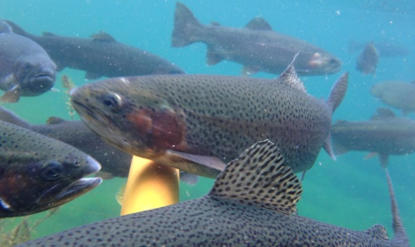
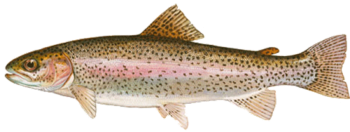
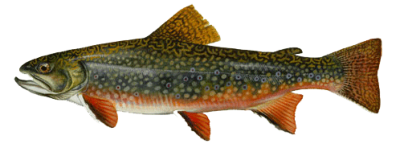
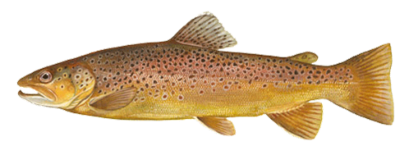
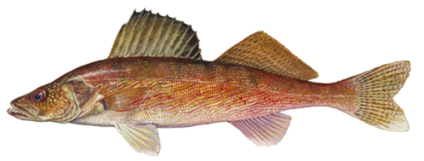
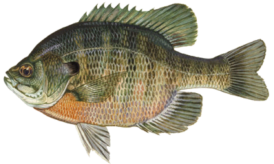
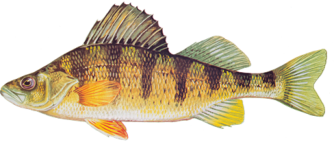
Copyright 2025 Watersmeet Trout Hatchery & Fish Farm. All rights reserved.
For any website problems, contact North Country Website Design.

Pond/Lake
Stocking
We offer Rainbow, Brook, Brown Trout, Hybrid Blue Gill, Yellow Perch, Largemouth Bass, Smallmouth Bass and Fathead Minnows, Crappie, Walleye, Bluegill & Channel Catfish - Please call for availability and prices.Stocking Prices
2025 Stocking PricesSpecies Information
Rainbow Trout Brook Trout Brown Trout Walleye Bluegill Yellow PerchRainbow Trout
(Oncorhynchus mykiss)
Identifying characteristics: (Non-Native Fish) Rainbow trout are generally blue-green or olive green with heavy black spotting over the length of the body. The tail fin is squarish and slightly forked. Adult fish have a broad pink or reddish stripe along the lateral line, from gills to the tail, which is most pronounced in breeding males. Although not native to Michigan, rainbow trout have become one of the state's favorite sport fish. From the inland lakes and streams to the Great Lakes, rainbows provide countless hours of angling enjoyment to all manner of fishermen. Adult rainbow trout reach an average of 10-13 inches and weigh between 1 and 5 lbs, although some may reach upwards of 20 inches in length. They prefer cool, clear rivers, streams, and lakes, though some will leave their freshwater homes and follow a river out to the sea. These migratory adults, called steelheads because they acquire more silvery markings, will spend several years in the ocean, but must return to the stream of their birth to spawn. Rainbow trout generally spawn in early to late spring when water temperatures reach at least 42° to 44° F. Spawning sites are usually a bed of fine gravel. A female trout clears a redd (or spawning bed) in the gravel by turning on her side and beating her tail up and down. Female rainbow trout usually produce 2000 to 3000 eggs per kilogram of weight. During spawning, the eggs fall into spaces between the gravel, and immediately the female begins digging at the upstream edge of the nest, covering the eggs with the displaced gravel. The eggs usually hatch in about four to seven weeks. In approximately two weeks, the yolk sac is completely consumed and fry commence feeding mainly on zooplankton. Rainbow trout are predators with a varied diet and will eat nearly anything they can capture. Rainbow trout routinely feed on larval, pupal and adult forms of aquatic insects (typically caddisflies, stoneflies, mayflies and aquatic diptera). Like any trout, stream rainbows can be caught with a various baits and lures including worms, crickets, grasshoppers, wet and dry flies, spoons, and spinners.Brook Trout
(Salvelinus Fontinalis)
Identifying characteristics: (Native Fish) Brook trout have a long, streamlined body with a large mouth that extends past the eye. Color variations include olive, blue-gray, or black above with a silvery white belly and wormlike markings (vermiculations) along the back. They have red spots sometimes surrounded by bluish halos on their sides. The lower fins have a white front edge with black and the remainder being reddish orange. The tail fin is square or rarely slightly forked. During breeding time in the fall male brook trout can become very bright orange-red along the sides. The brook trout is native to Michigan’s waters and is the state fish of Michigan. They can be found throughout most of the state in many creeks, streams, rivers, lakes, and in the Great Lakes. Brook trout require cool, clear, spring-fed streams and pools. They can be found under cover of rocks, logs, and undercut banks and have been described as stationary. Larger brook trout often inhabit deep pools moving to shallow water only to feed. They prefer temperatures from 57-60° F.Brown Trout (Salmo
Trutta)
Identifying characteristics: (Non-Native Fish) Two dorsal fins including one adipose fin, broad square tongue with 11-12 large teeth, light pectoral fins, squire tail, 9-10 rays in the anal fin. Brown trout is something of a misnomer for many Great Lakes members of this species, since lake-run browns are predominately silver in color. In addition, the body spots, so characteristic of their stream-dwelling cousins, are often obscured in lake- dwellers. Brown trout are close relative of the Atlantic salmon, and also were brought to North American waters as exotics. These natives of Europe and western Asia were introduced into New York and Michigan waters in 1883. Brown trout have thrived in their new home, and have become firmly established in all of our upper Great Lakes waters. Lake dwelling brown trout are a wary lot. They hide in shallow water weed beds and rocky, boulder- strewn areas, and prefer a water temperature of 65- 75° F. Since brown trout spawn in tributary streams in September and October, they begin to take up residence near stream outlets in spring and early summer. After ascending a particular stream, brown trout spawners choose shallow, gravelly or rocky areas. The female creates a shallow depression (redd) in the gravel, in which the spawning fish deposit the eggs and sperm. When the process is completed, the female covers the redd with gravel. The average lake run adult weighs 8 pounds, although individuals can grow to be much larger. Young browns are preyed upon by larger fish and by predatory birds such as mergansers. The diet of adult brown trout includes insects and their larvae, crustaceans, mollusks, amphibians, small rodents and other fish. They enjoy a rather long life-span, it appears, since researchers have observed them at up to 13 years of age.Walleye (Sander
Vitreus)
Identifying characteristics: (Native Fish) Two dorsal fins separated into a spiny and a soft-rayed portion, cloudy eye, white tips on anal and lower caudal fins, canine teeth. Walleye are the largest member of the perch family. They lack the distinctive vertical bar makings of the yellow perch and have fan-like canine teeth. These battling fish are exciting to catch, delicious to eat and because they feed actively all winter, they provide a fine year-round sport fishery. In spring and fall walleyes congregate in shallow bay waters of the great Lakes, where they seek out rocky areas and submerged bars. During the bright part of the day they retreat in schools to the shade of deep waters or submerged objects. In the summer, walleyes range into cooler, deeper waters. They prefer a water temperature of 55-68° F and are seldom found in waters deeper than 50 feet. Walleyes are greedy predators. They eat small bass, trout, pike, perch and sunfishes. Prime feeding times are early morning and evening. Although in turbid waters walleyes are active throughout the day. Walleyes often associate with yellow perch, smallmouth bass, northern pike and muskellunge. In April and May, walleyes spawn over rock shoals. Males mature at age two to four years, females at three to six years. The average walleye caught by anglers is three years old and weighs from one to three pounds. Northern pike and muskellunge prey heavily on walleyes, while yellow perch, smallmouth bass and lake whitefish compete with walleyes for food. A close relative and look-alike of the walleye, the sauger shares habitat and, to some extent food sources with walleyes. Sauger are more adaptable to turbid water than walleyes are. Like walleyes, they are sight feeders which shy away from intense light, so they are most active at dawn, dusk and on cloudy days. Immature augers feed on plankton and aquatic insects, while adults prey on small fish, insects, crayfish and leeches.Bluegill (Lepomis
Macrochirus)
Identifying characteristics: (Native Fish) Two dorsal fins with spinous and soft-rayed portions united, small mouth, long pointed pectoral fins, faint black spot on soft-rayed part of dorsal fin separates the bluegill from other sunfish, which lack this dorsal coloration. The sunfish family, or Centrarchidae, includes such popular panfish as bluegills, rock bass and large and smallmouth bass. The members of this family resemble the perch and sea bass families, but they differ in that the sinous and soft portions of the dorsal fin are united and confluent. The large mouth bass is an exception, with a deep notch between the front and rear parts of the dorsal fin. The Centrarchidae generally prefer warm water, and are nesting fishes. That is, the males scoop out a depression where one or more females deposit eggs. The males then fertilize and guard the eggs and the newly hatched young. The bluegill is a native to eastern and central North America, including the lower Great Lakes. This fish enjoys a well-deserved popularity with anglers. Many a young angler boasts the delicious bluegill as a first catch, while seasoned anglers using light tackle find it a valiant fighter. Bluegills favor warm waters (64-70° F) with plenty of cover such as weed beds, submerged logs, or drop-offs. They usually stay in relatively shallow water, but as temperatures rise in the summer, large bluegills will head for deeper water. This fish also provides good winter sport since it remains active all winter long. The bluegill spawns in the shallows in the late spring or early summer when the water temperature reaches 65° F. Males build nesting colonies in gravel, sand or mud and will guard the eggs and newly hatched fry until they reach the swimming stage. The young fry eat algae and zooplankton. As they grow larger, bluegills add small fish, aquatic insects and plant matter to their diet. The bluegill feeds off the surface of the water the midwaters and the bottom, where it can be a serious competitor with other bottom feeding fish. The average adult bluegill is 6 to 8 inches long, although some reach 10 inches. Sexual maturity occurs at 2 to 3 years for males and 3 to 4 years for females. Average life-span of these fish is 5 to 6 years.Yellow Perch (Perca
Flavescens)
Identifying characteristics: (Native Fish) Two dorsal fins separated into a spiny and soft-rayed portion, yellow sides, seven blackish bars on the sides, no canine teeth. The yellow perch and walleye, members of the Percidae or perch family, are characterized by a dorsal fin, which is completely divided into a spiny and a separate soft-rayed portion. Both are important game fish in the Great Lakes area. Yellow perch have the distinction of being the most frequently caught game fish in Michigan. In addition their reputation as a tasty treat makes them a doubly valuable Great Lakes product. The gregarious perch travel in schools, generally preferring relatively shallow waters near shore. They are rarely taken from waters more than 30 feet deep, although in spring and fall they inhabit shallower areas than they do in the heat of the summer, they tend to travel shoreward each morning and evening to feed, while during the spring and fall they appear to feed throughout the day. At night they appear to rest on the bottom and refrain from feeding. Unlike many Great Lakes fish species, perch remain active all winter long under the ice in both shallow and deeper water, hence they provide the ice fisherman with much sport and many a meal. When given the choice, perch prefer a water temperature of 66-70° F and some suggest they follow the 68° F water temperature levels in their seasonal movements. They inhabit all the Great Lakes, with greatest Michigan concentrations in Lake Erie, Lake St. Clair, Saginaw Bay, the eastern end of the U.P. and southern Michigan. Adult perch dine primarily on immature insects, larger invertebrates, (crayfish, etc.) and the eggs and young of other fish, which they take both from open water and from the bottom. In turn, bass, walleye, and northern pike all prey on perch. Perch average adult length is 4-10 inches, with a weight of 4-10 ounces, although adult size is quite variable. Perch are prolific breeders, but growth and ultimate size depend on population density and habitat productivity. Crowding results in stunted offspring that may never exceed a length of six inches; thus, a controlled harvest program can benefit both the angler and the fish themselves. Male perch reach sexual maturity at about three years of age, females at four. Perch spawn in the spring, laying eggs in gelatinous strings over dense vegetation, roots, and fallen trees in the shallows. These spawning grounds provide some of the best perch fishing available. Great Lakes perch populations were severely crowded and reduced in the late 1960s by the alewife, but perch are adaptable, and have staged a comeback that shows us they are here to stay.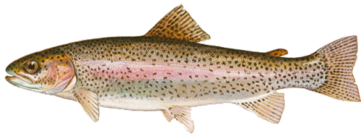
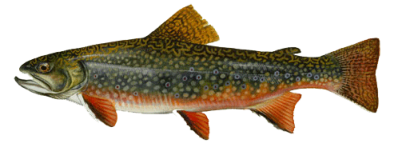
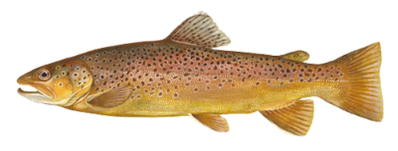
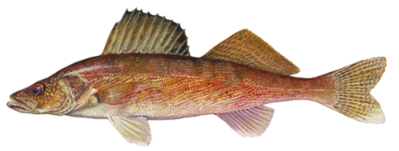



Copyright 2025 Watersmeet Trout Hatchery.
Website by North Country Website Design.















